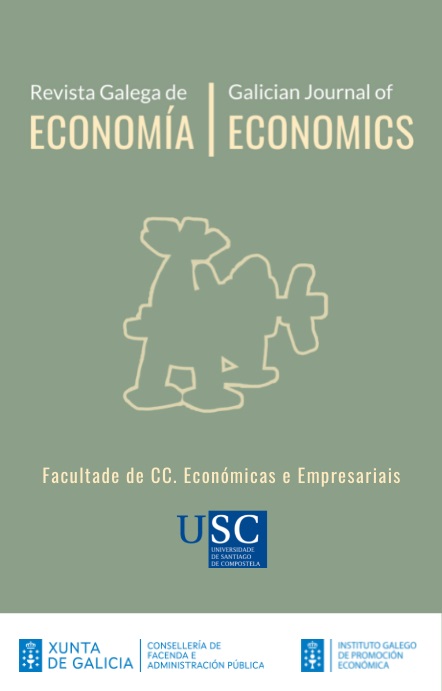FACTORES CHAVE DE IMPLANTACIÓN/CERTIFICACIÓN DA NORMA UNE 302001 DE TURISMO INDUSTRIAL NA COMUNIDADE AUTÓNOMA DE GALICIA
Contido principal do artigo
Resumo
Palabras chave
Detalles do artigo
Citas
AENOR (2012): Norma UNE 302001:2012. Turismo Industrial. Requisitos para la prestación del servicio, Madrid.
BEIRÃO, G.; SARSFIELD, J.A. (2002): “The reaction of the Portuguese stock market to ISO 9000 certification”, Total Quality Management, vol. 13, núm. 4, pp. 465-474.
BELOHLAV, J. (1993): “Quality, strategy and competitiveness”, California Management Review, vol. 35, núm. 3, Spring, pp. 55-67.
BROWN, A.; VAN DER WIELE, A. (1995): “Industry experience with ISO 9000”, Asia Pacific Journal of Quality Management, vol. 4, pp. 8-17.
BROWN, A.; VAN DER WIELE, T.; LOUGHTON, K. (1998): “Smaller enterprises experiences with ISO 9000”. International Journal of Quality & Reliability Management, vol. 15, núm. 3, pp. 273-285.
BRYDE, D. J.; SLOCOCK, B. (1998): “Quality management systems certification: a survey”, International Journal of Quality & Reliability Management, vol. 15, núm. 5, pp. 467-480.
CAMISÓN, C. (1996): “La calidad como factor de competitividad en Turismo: Análisis del caso español”¸ Información Comercial Española, núm. 749, Enero, pp. 99-117.
CARRASCO FERNÁNDEZ, S. (2009): Procesos de gestión de calidad en hostelería y turismo, Vértice, Málaga.
CARRASCO FERNÁNDEZ, S. (2013): Procesos de gestión de calidad en hostelería y turismo, Paraninfo Thomson Learning, Madrid.
CARLSSON, M.; CARLSSON, D. (1996). “Experiences of implementing ISO 9000 in Swedish industry”, International Journal for Quality & Reliability Management, vol. 13, núm. 7, pp. 36-47.
CONTI, T. (1993): Building Total Quality: A guide for Management, Chapman & Hall, Londres.
FERNÁNDEZ SÁNCHEZ, E. (1996): “Factores determinantes de la competitividad empresarial”, Esic Market, Octubre-Diciembre, pp. 119-134.
FORONDA ROBLES, C.; GARCÍA LÓPEZ, A.Mª. (2009): “La apuesta por la calidad como elemento diferenciador en los destinos turísticos”, Cuadernos de Turismo, núm. 23, pp. 89-110.
GARVIN, D.A. (1987): “Competing on the eight dimensions of Quality”, Harvard Business Review, vol. 65, pp. 101-109.
GRANT, R.M; SHANI, R.; KRISHNAN, R. (1994): “TQM´s challenge to management theory and practice”, Sloan Management Review, vol. 35, núm. 2, pp. 25-35.
GUSTAFSSON, R.; KLEFSJÖ, B.; BERGGREN, E.; GRANFORS-WELLEMETS, U. (2001): “Experiences from implementing ISO 9000 in small enterprises. a study of Swedish organisations”, The TQM Magazine, vol. 13, núm. 4, pp. 232-246.
HUARNG, F.; HORNG, C.; CHEN, C. (1999): “A study of ISO 9000 process, motivation and performance”, Total Quality Management, vol. 10, núm. 7, pp. 1009-1026.
JONES, R.; ARNDT, G.; KUSTIN, R. (1997): “ISO 9000 among Australian companies: impact of time and reasons for seeking certification on perceptions of benefits received”, International Journal of Quality & Reliability Management, vol. 14, núm. 7, pp. 650-660.
KAIBEL, E. (1990): “Calidad y Competitividad”, Alta Dirección, núm. 149, pp. 9-16.
LLOPIS, J.; TARÍ, J.J. (2003): “The importance of internal aspects in quality improvement”, International Journal of Quality & Reliability Management, vol. 20, núm. 3, pp. 304-324.
MARTÍNEZ CARBALLO, M.; RÍO RAMA, Mª.C. DEL; GUILLÉN SOLÓRZANO, E.; BARBEITO ROIBAL, S. (2006): “Factores claves de implantación de la Marca Q de Calidad Turística. Análisis en la Comunidad Autónoma de Galicia”, XX Reunión Anual de la ASEPELT, pp. 3041-3060.
MARTÍNEZ FUENTES, C.; BALBASTRE, F.; ESCRIBÁ, M.A.; GONZÁLEZ CRUZ, T.; PARDO, M. (2000): “Analysis of the implementation of ISO 9000 quality assurance systems”, Work Study, vol. 49, núm. 6.
MEEGAN, S.T.; TAYLOR, W.A. (1997): “Factors influencing a successful transition from ISO 9000 to TQM. The influence of understanding and motivation”, International Journal of Quality & Reliability Management, vol. 14, núm. 2, pp. 100-117.
MEMBRADO MARTÍNEZ, J. (2002): Innovación y Mejora Continua según el Modelo EFQM de Excelencia, 2ª edic., Ed. Díaz de Santos, Madrid.
POWELL, T.C. (1995): “Total Quality Management as competitive advantage: A review and empirical study”, Strategic Management Journal, vol. 16, núm. 1, pp. 15-37.
RAYNER, P.; PORTER, L.J. (1991): “BS 5750/ISO 9000. The experiences of small and medium sized firms”, International Journal of Quality & Reliability Management, vol. 8, núm. 6, pp. 16-28.
ROSS, J.E.; SHETTY, Y.K. (1985): “Making Quality a fundamental part of Strategy”, Long Rang Planning, vol. 8, núm. 1, pp. 53-58.
SARABIA, J.M.; LÓPEZ, M.C.; SERRANO, A.M. (1994): “Un arma estratégica para los 90: Dirección de calidad y para la calidad”, Dirección y Organización, vol. 11, núm. 3, pp. 5-13.
SPITZER, R.D. (1993): “Total Quality Management: The only source of sustainable competitive advantage”, Quality Progress, vol. 26, núm. 6, pp. 59-64.
TAYLOR, W.A. (1995): “Organizacional differences in ISO 9000 implementation practices”, International Journal of Quality & Reliability Management, vol. 12, núm. 7, pp. 10-27.
TSIOTRAS, G.; GOTZAMANI, K. (1996): “ISO 9000 as an entry key to TQM: the case of Greek industry”, International Journal of Quality & Reliability Management, vol. 13, núm. 4, pp. 64-76.






